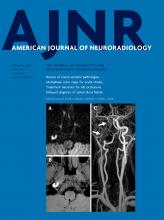Index by author
Asada, Y.
- Extracranial VascularOpen AccessCharacterization of Carotid Plaque Components by Quantitative Susceptibility MappingM. Azuma, K. Maekawa, A. Yamashita, K. Yokogami, M. Enzaki, Z.A. Khant, H. Takeshima, Y. Asada, Y. Wang and T. HiraiAmerican Journal of Neuroradiology February 2020, 41 (2) 310-317; DOI: https://doi.org/10.3174/ajnr.A6374
Asemani, D.
- LetterYou have accessReply:D.R. Roberts, D. Asemani, P.J. Nietert, M.A. Eckert, D.C. Inglesby, J.J. Bloomberg, M.S. George and T.R. BrownAmerican Journal of Neuroradiology February 2020, 41 (2) E8; DOI: https://doi.org/10.3174/ajnr.A6400
Azuma, M.
- Extracranial VascularOpen AccessCharacterization of Carotid Plaque Components by Quantitative Susceptibility MappingM. Azuma, K. Maekawa, A. Yamashita, K. Yokogami, M. Enzaki, Z.A. Khant, H. Takeshima, Y. Asada, Y. Wang and T. HiraiAmerican Journal of Neuroradiology February 2020, 41 (2) 310-317; DOI: https://doi.org/10.3174/ajnr.A6374
Baik, S.K.
- NeurointerventionYou have accessAsymptomatic Cerebral Vasoconstriction after Carotid Artery StentingC.H. Kang, J. Roh, J.A. Yeom, S.H. Ahn, M.G. Park, K.P. Park and S.K. BaikAmerican Journal of Neuroradiology February 2020, 41 (2) 305-309; DOI: https://doi.org/10.3174/ajnr.A6385
Bakhru, A.
- EDITOR'S CHOICEAdult BrainYou have accessSpiral T1 Spin-Echo for Routine Postcontrast Brain MRI Exams: A Multicenter Multireader Clinical EvaluationM.B. Ooi, Z. Li, R.K. Robison, D. Wang, A.G. Anderson, N.R. Zwart, A. Bakhru, S. Nagaraj, T. Mathews, S. Hey, J.J. Koonen, I.E. Dimitrov, H.T. Friel, Q. Lu, M. Obara, I. Saha, H. Wang, Y. Wang, Y. Zhao, M. Temkit, H.H. Hu, T.L. Chenevert, O. Togao, J.A. Tkach, U.D. Nagaraj, M.C. Pinho, R.K. Gupta, J.E. Small, M.M. Kunst, J.P. Karis, J.B. Andre, J.H. Miller, N.K. Pinter and J.G. PipeAmerican Journal of Neuroradiology February 2020, 41 (2) 238-245; DOI: https://doi.org/10.3174/ajnr.A6409
The authors report a multicenter multireader study that was designed to compare spiral with standard-of-care Cartesian postcontrast structural brain MR imaging on the basis of relative performance in 10 metrics of image quality, artifact prevalence, and diagnostic benefit. Seven clinical sites acquired 88 total subjects. For each subject, sites acquired 2 postcontrast MR imaging scans: a spiral 2D T1 spin-echo, and 1 of 4 routine Cartesian 2D T1 spin-echo/TSE scans. Nine neuroradiologists independently reviewed each subject, with the matching pair of spiral and Cartesian scans compared side-by-side, and scored the subject on 10 image-quality metrics. Spiral was superior to Cartesian in 7 of 10 metrics (flow artifact mitigation, SNR, GM/WM contrast, image sharpness, lesion conspicuity, preference for diagnosing abnormal enhancement, and overall intracranial image quality), comparable in 1 of 10 metrics (motion artifacts), and inferior in 2 of 10 metrics (susceptibility artifacts, overall extracranial image quality). Spiral 2D T1 spin-echo for routine structural brain MR imaging is feasible in the clinic with conventional scanners and was preferred by neuroradiologists for overall postcontrast intracranial evaluation.
Bardis, M.
- Adult BrainYou have accessPredictive Value of Noncontrast Head CT with Negative Findings in the Emergency Department SettingA.L. Callen, D.S. Chow, Y.A. Chen, H.R. Richelle, J. Pao, M. Bardis, B.D. Weinberg, C.P. Hess and L.P. SugrueAmerican Journal of Neuroradiology February 2020, 41 (2) 213-218; DOI: https://doi.org/10.3174/ajnr.A6408
Baum, S.A.
- Adult BrainOpen AccessA Method to Estimate Brain Volume from Head CT Images and Application to Detect Brain Atrophy in Alzheimer DiseaseV. Adduru, S.A. Baum, C. Zhang, M. Helguera, R. Zand, M. Lichtenstein, C.J. Griessenauer and A.M. MichaelAmerican Journal of Neuroradiology February 2020, 41 (2) 224-230; DOI: https://doi.org/10.3174/ajnr.A6402
Behbahani, S.
- FELLOWS' JOURNAL CLUBSpine Imaging and Spine Image-Guided InterventionsYou have accessRenal Excretion of Contrast on CT Myelography: A Specific Marker of CSF LeakS. Behbahani, J. Raseman, H. Orlowski, A. Sharma and R. EldayaAmerican Journal of Neuroradiology February 2020, 41 (2) 351-356; DOI: https://doi.org/10.3174/ajnr.A6393
The authors performed a retrospective review of postmyelographic CT scans from 49 consecutive patients seen between January 2009 and August 2018 with imaging and/or clinical findings related to intracranial hypotension. Each scan was evaluated by both a neuroradiology fellow and a board-certified neuroradiologist for the presence of contrast in the renal excretory system. A similar assessment was also performed on 90 consecutive control subjects who underwent CT myelography for alternative indications. Among the 49 patients with suspected CSF leak, 21 (43%) had an overt CSF leak on postmyelographic CT (group 1) and 28 (57%) did not (group 2). Overall, renal contrast was identified in 7/49 patients (14.3%): 5 (24%) patients in group 1, and 2 (7%) patients in group 2. Renal contrast was not seen in any of the 90 controls on postmyelographic CT. Renal contrast was exclusively seen in patients with a clinically or radiographically suspected CSF leak. Identification of this finding should prompt a second look for subtle myelographic contrast extravasation or an underlying CSF-venous fistula.
Bello, J.A.
- Spine Imaging and Spine Image-Guided InterventionsYou have accessDifferentiation between Tuberculous and Pyogenic Spondylodiscitis: The Role of the Anterior Meningovertebral Ligament in Patients with Anterior Epidural AbscessS.B. Strauss, S.R. Gordon, J. Burns, J.A. Bello and S.E. SlaskyAmerican Journal of Neuroradiology February 2020, 41 (2) 364-368; DOI: https://doi.org/10.3174/ajnr.A6370
Benson, J.C.
- Head and Neck ImagingOpen AccessThe Forgotten Second Window: A Pictorial Review of Round Window PathologiesJ.C. Benson, F. Diehn, T. Passe, J. Guerin, V.M. Silvera, M.L. Carlson and J. LaneAmerican Journal of Neuroradiology February 2020, 41 (2) 192-199; DOI: https://doi.org/10.3174/ajnr.A6356








